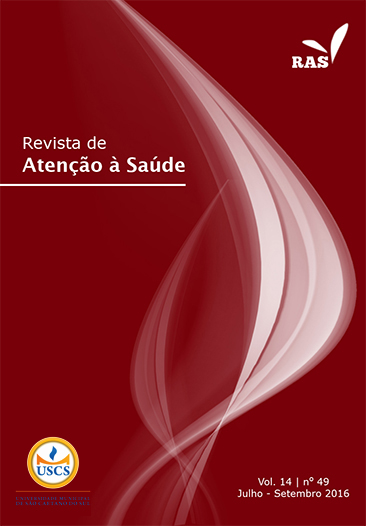Hepatoprotective potencial of renisus medicinal plants: sistematic review
DOI:
https://doi.org/10.13037/ras.vol14n49.3739Keywords:
liver, hepatitis, medicinal plants, primary health careAbstract
Introduction: The injury or liver dysfunction is considered a serious health problem. Synthetic drugs available to treat liver diseases are expensive and can cause adverse effects with prolonged use. Thus, the hepatoprotective effects of plants have been investigated. Objectives: To quantify the research that refer therapeutic potential for liver diseases from the study with RENISUS plants, published between 2010 and May 2014 in two scientific databases (SciELO and Science Direct) and one publisher of scientific journals, Springer. Methodology: The initial search resulted in the selection of 21,357 articles found in the databases. The analysis was first carried out from reading the title of publications. The articles selected in this step were evaluated by reading the abstracts. Finally, the texts of the articles selected in the previous step were read in their entirety, having been selected pre-clinical and clinical studies which have shown hepatoprotective therapeutic potential. Results: This selection resulted in 13 articles of interest, of which five studies were conducted with the Curcuma longa plant. Conclusions: The results provide theoretical basis for discussions in the field of Public Health on alternative treatments based on medicinal plants as a therapeutic adjuvant. In this sense, the correct use of these plants, added to conventional therapy, can help improve the health of patients with liver disorders.
Downloads
References
Adewusi EA, Afolayan AJ. A review of natural products with hepatoprotective activity. J Med Plants Res. 2010;4(13):1318-34.
Kumar CH, Ramesh A, Kumar JNS, Ishaq BM. A review on hepatoprotective activity of medicinal plants. Int J Pharm Sci Res. 2011;2(3):501-15.
Harish R, Shivanandappa T. Antioxidant activity and hepatoprotective potential of Phyllanthus Niruri. Food Chem. 2006;95(2):180-5.
World Health Organization. Fact sheet nº 204 [Internet]. 2015 [acesso em 2016 ago 01]. Disponível em: http://www.who.int/mediacentre/factsheets/fs204/en/
Lozano R, Naghavi M, Foreman K, Lim S, Shibuya K, Aboyans V, et al. Global and regional mortality from 235 causes of death for 20 age groups in 1990 and 2010: a systematic analysis for the Global Burden of Disease Study 2010. Lancet. 2012;380(9859):2095-128.
Kapur V, Pillai KK, Hussian SZ, Balani DK. Hepatoprotecitve activity of “jigrine” on liver damage caused by Alcohol-Carbon tetrachloride and paracetamol in rats. Indian J Pharmacol. 1994;26:35-40.
Sotelo-Félix JI, Martinez-Fong D, Muriel D, Santillán RL, Castillo D, Yahuaca P, et al. Evaluation of the effectiveness of Rosmarinus officinalis (Lamiaceae) in the alleviation of carbon tetrachloride induced acute hepatotoxicity in rats. J Ethnopharmacol. 2002;81(2):145-54.
Levy C, Seeff LD, Lindor KD. Use of herbal supplements for chronic liver disease. Clin Gastroenterol Hepatol. 2004;2(11):947-56.
Newman DJ, Cragg GM. Natural products as sources of new drugs over the 30 years from 1981 to 2010. J Nat Prod. 2012;75(3):311-35.
Brasil. Ministério da Saúde. Portal da Saúde: Relação Nacional de Medicamentos Essenciais (RENAME) [Internet]. 2013 [acesso em 2016 ago 01]. Disponível em: http://bvsms.saude.gov.br/bvs/saudelegis/gm/2012/prt0533_28_03_2012.html
Brasil. Ministério da Saúde. Portal da Saúde: Programa Nacional de Plantas Medicinais e Fitoterápicos [Internet]. 2009 [acesso em 2016 ago 01]. Disponível em: http://portalsaude.saude.gov.br/images/pdf/2015/janeiro/05/programa-nacional-plantas-medicinais-fitoter--picos-pnpmf.pdf
Pereira BS, Nunes-Pinheiro DCS, Vasconcelos AKP, Pinheiro ADN, Rodrigues PA. Atividade hepatoprotetora dos extratos etanólico e hexânico das folhas de Momordica charantia. Rev Bras Plantas Med. 2010;12(3):311-6.
Tu CT, Yao QY, Xu BL, Zhang SC. Curcumin protects against concanavalin A-induced hepatitis in mice through inhibiting the cytoplasmic translocation and expression of high mobility group box 1. Inflammation. 2013;36(1):206-15.
Banerjee S, Chattopadhyay K, Chhabra JK, Chattopadhyay B. Protein dependent fate of hepatic cells under nicotine induced stress and curcumin ameliorated condition. Eur J Pharmacol. 2012;684(1-3):132-45.
Chang YJ, Tai CJ, Kuo LJ, Wei PL, Liang HH, Liu TZ, et al. Glucose-regulated protein 78 (GRP78) mediated the efficacy to curcumin treatment on hepatocellular carcinoma. Ann Surg Oncol. 2011;18(8):2395-403.
Hung CS, Liu HH, Huang MT, Cheng CW, Kuo LJ, Ho YS, et al. Knockdown survivin expression reduces the efficacy of curcumin treatment in hepatocellular carcinoma cells. Ann Surg Oncol. 2012;19(11):3547-55.
El-Amir YO, Hassanein KMA. Protective effect of curcumin on N-nitrosodiethylamine and carbon tetrachloride-induced hepatocarcinogenesis in Sprague-Dawley rats. Comp Clin Path. 2012;22(4):631-6.
Meng Y, Liu B, Lei N, Zheng J, He Q, Li D, et al. Alpha-momorcharin possessing high immunogenicity, immunotoxicity and hepatotoxicity in SD rats. J Ethnopharmacol. 2012;139(2):590-8.
Fang EF, Zhang CZ, Wong JH, Shen JY, Li CH, Ng TB. The MAP30 protein from bitter gourd (Momordica charantia) seeds promotes apoptosis in liver cancer cells in vitro and in vivo. Cancer Lett. 2012;324(1):66-74.
Nwokocha CR, Owu DU, Nwokocha MI, Ufearo CS, Iwuala MO. Comparative study on the efficacy of Allium sativum (garlic) in reducing some heavy metal accumulation in liver of Wistar rats. Food Chem Toxicol. 2012;50(2):222-6.
Zhang L, Zhang H, Miao Y, Wu S, Ye H, Yuan Y. Protective effect of allicin against acrylamide-induced hepatocyte damage in vitro and in vivo. Food Chem Toxicol. 2012;50(9):3306-12.
Abdel-Salam OME, Sleem AA, Shafee N. Hepatoprotective effects of Cynara extract and silymarin on carbon tetrachloride-induced hepatic damage in rats. Comp Clin Pathol. 2014;23(3):709-16.
Mishra R, Bhadauria S, Murthy PK, Murthy PS. Glycine soya diet synergistically enhances the suppressive effect of tamoxifen and inhibits tamoxifen-promoted hepatocarcinogenesis in 7,12-dimethylbenz[α]anthracene-induced rat mammary tumor model. Food Chem Toxicol. 2011;49(2):434-40.
Ahmed D, Sharma M, Mukerjee A, Ramteke PW, Kumar V. Improved glycemic control, pancreas protective and hepatoprotective effect by traditional poly-herbal formulation “Qurs Tabasheer” in streptozotocin induced diabetic rats. BMC Complement Altern Med. 2013;13:10.
Yaeesh S, Jamal Q, Khan AU, Gilani AH. Studies on hepatoprotective, antispasmodic and calcium antagonist activities of the aqueous-methanol extract of Achillea millefolium. Phytother Res. 2006;20(7):546-51.
Pramyothin P, Ngamtin C, Poungshompoo S, Chaichantipyuth C. Hepatoprotective activity of Phyllanthus amarus Schum. et. Thonn. extract in ethanol treated rats: in vitro and in vivo studies. J Ethnopharmacol. 2007;114(2):169-73.
Sharma SK, Suman, Vasudeva N. Hepatoprotective activity of Vitis vinifera root extract against carbon tetrachloride-induced liver damage in rats. Acta Pol Pharm. 2012;69(5):933-7.
Yadav NP, Dixit VK. Hepatoprotective activity of leaves of Kalanchoe pinnata Pers. J Ethnopharmacol. 2003;86(2-3):197-202.
Oh H, Kim DH, Cho JH, Kim YC. Hepatoprotective and free radical scavenging activities of phenolic petrosins and flavonoids isolated from Equisetum arvense. J Ethnopharmacol. 2004;95(2-3):421-4.
Harish R, Shivanandappa T. Antioxidant activity and hepatoprotective potential of Phyllanthus niruri. Food Chem. 2006;95(2):180-5.
Chandan BK, Saxena AK, Shukla S, Sharma N, Gupta DK, Suri KA, et al. Hepatoprotective potential of Aloe barbadensis Mill. against carbon tetrachloride induced hepatotoxicity. J Ethnopharmacol. 2007;111(3):560-6.
Gurib-Fakim A. Medicinal plants: traditions of yesterday and drugs of tomorrow. Molecular Aspects of Medicine. 2006;27(1):1-93.
Golan DE, Armstrong EJ, Armstrong AW, Vahle JL, Tashjian JAH. Princípios de Farmacologia: a base fisiopatológica da farmacoterapia. 2ª ed. Rio de Janeiro: Guanabara Koogan; 2009. 908 p.
Girish C, Koner BC, Jayanthi S, Ramachandra Rao K, Rajesh B, Pradhan SC. Hepatoprotective activity of picroliv, curcumin and ellagic acid compared to silymarin on paracetamol induced liver toxicity in mice. Fundam Clin Pharmacol. 2009;23(6):735-45.
El-Maraghy SA, Rizk SM, El-Sawalhi MM. Hepatoprotective potential of crocin and curcumin against iron overload-induced biochemical alterations in rat. Afr J Biochem Res. 2009;3(5):215-21.
Feitelson MA, Sun B, Tufan NLS, Liu J, Pan J, Lian Z. Genetic mechanisms of hepatocarcinogenesis. Oncogene. 2002;21(16):2593-604.
Brito SCD. Os efeitos do marco regulatório sobre a competitividade da cadeia produtiva de medicamentos fitoterápicos no Brasil [dissertação]. Palmas: Fundação Universidade Federal de Tocatins; 2010.
Brasil. Ministério da Saúde. Portal da Saúde. Saúde dobra investimento em projetos de produção de plantas medicinais e fitoterápicos. [Internet]. 2013 [acesso em 2016 ago 01]. Disponível em: http://portalsaude.saude.gov.br/images/pdf/2014/julho/09/edital-sctie-1-2014-disposicoes-gerais-apl.pdf
Brasil. Ministério da Saúde. Portal da Saúde. [Internet]. Edital SCTIE nº 2, de 24 de agosto de 2015. [acesso em 2016 ago 01]. Disponível em: http://portalsaude.saude.gov.br/images/pdf/2015/agosto/26/edital-sctie-2-2015-disposicoes-gerais.pdf
Downloads
Published
Issue
Section
License
Policy Proposal for Journals offering Free Delayed Access
Authors who publish in this magazine agree to the following terms:
- Authors maintain the copyright and grant the journal the right to the first publication, with the work simultaneously licensed under a Creative Commons Attribution License after publication, allowing the sharing of the work with recognition of the authorship of the work and initial publication in this journal.
- Authors are authorized to assume additional contracts separately, for non-exclusive distribution of the version of the work published in this magazine (eg, publishing in institutional repository or as a book chapter), with the acknowledgment of the authorship and initial publication in this journal.
- Authors are allowed and encouraged to publish and distribute their work online (eg in institutional repositories or on their personal page) at any point before or during the editorial process, as this can generate productive changes, as well as increase impact and citation of the published work (See The Effect of Open Access).









